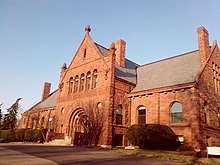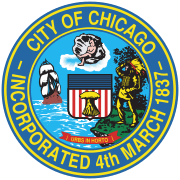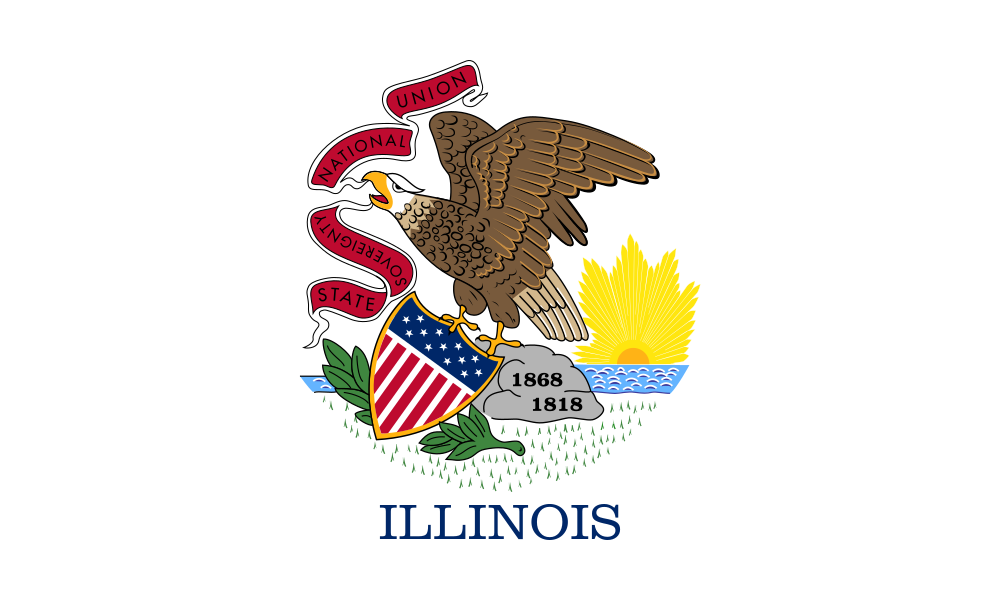Lake Forest College
Lake Forest College is a private liberal arts college in Lake Forest, Illinois. Founded in 1857 as Lind University by a group of Presbyterian ministers, the college has been coeducational since 1876 and an undergraduate-focused liberal arts institution since 1903.[5] Lake Forest enrolls approximately 1,600 students representing 47 states and 81 countries. Lake Forest offers 30 undergraduate major and minor programs in the humanities, social sciences, and natural sciences, and features programs of study in pre-law, pre-medicine, communication, business, finance, and computer science.[3] The majority of students live on the college's wooded 107-acre campus located a half-mile from the Lake Michigan shore.
 | |
| Motto | Et veritas liberabit vos (Latin) |
|---|---|
Motto in English | And the truth shall set you free[1] (John 8:32) |
| Type | Private liberal arts college |
| Established | 1857 |
| Affiliation | Nonsectarian Presbyterian (historically) |
| Endowment | $90.6 million (2019)[2] |
| President | Stephen D. Schutt |
| Provost | Davis Schneiderman |
Academic staff | 178[3] |
| Students | 1,592[3] |
| Location | , , United States 42.2496°N 87.8285°W |
| Campus | Suburban, 107 acres (43 ha) |
| Colors | Red and black [4] |
| Athletics | NCAA Division III Midwest, NCHA |
| Nickname | Foresters |
| Affiliations | ACM Annapolis Group Oberlin Group CLAC APCU |
| Mascot | Boomer the Bear |
| Website | www.lakeforest.edu |
Lake Forest is affiliated with the Associated Colleges of the Midwest. The college has 19 varsity teams which compete in the NCAA Division III Midwest Conference.
History

Lake Forest College was founded in 1857 by Reverend Robert W. Patterson as a Presbyterian alternative to the Methodist Northwestern University in Evanston. It was originally named Lind University after Sylvester Lind, who had given $80,000 to launch the school.[5] Patterson and his fellow Chicago Presbyterians established the town of Lake Forest and the university roughly halfway between Evanston and Waukegan two years after the Chicago and Milwaukee Railway began service from Chicago. They hired St. Louis landscape architect Almerin Hotchkiss to design the town of Lake Forest with a university park at its center. Hotchkiss used the area's wooded ravines and forest as guidelines to plat a park-like, curvilinear layout for the town.
Lake Forest Academy, a boys' preparatory school and the first project of the university, began offering classes in 1858; collegiate-level courses began in 1860. By the mid-1860s, a small New England-style village had been established with an academy building, a Presbyterian church and several homes. The school had a medical college from 1859–1863, which later split off and eventually became part of Northwestern University, now known as the Northwestern University Feinberg School of Medicine.
In 1865, the name became Lake Forest University. In 1869 Ferry Hall, a girls' preparatory school and junior college, opened as a division of the university.[6] It later merged with Lake Forest Academy in 1974.
In 1876 Mary Eveline Smith Farwell started Lake Forest College, a coeducational division of the university, under the leadership of the Reverend Patterson. In 1878, College Hall (now Young Hall) was built following a fire that destroyed the former hotel being used for classes.
The Reverend James Gore King McClure arrived in Lake Forest in 1881 as the pastor of the Presbyterian Church. Under his influence over the next 50 years, the college experienced a large transition "from a pluralistic graduate and professional emphasis to a singular undergraduate liberal arts focus," says Lake Forest College archivist Art Miller, who co-wrote 30 Miles North: A History of Lake Forest College, Its Town, and Its City of Chicago.[7] During this time, the college's theater group, the Garrick Players, the yearbook, and student newspaper, The Stentor, were all formed.
In 1890 Lake Forest established a relationship with the Chicago College of Dental Surgery, Chicago's first dental school, to serve as its dental department. This affiliation ended in 1902.
The Lake Forest School of Music opened as a division of the university in 1916, incorporating and extending the courses in music hitherto given in other departments. A summer school of landscape architecture was instituted in 1916.[6]
By 1925, Lake Forest College split from Lake Forest Academy, and the school's only focus was on undergraduate liberal arts. Following World War II, the college experienced further growth, taking control of what is now South Campus and constructing the Alumni Memorial Fieldhouse.
In 1960, William Graham Cole, from Williams College, took over as president and brought with him Eastern faculty and students, further diversifying the campus. During his time as president, in 1965, the school's name was officially changed to Lake Forest College.[5] In March 2010, the college received $7 million from alumna Grace Groner.[8]
Faculty
The teaching faculty consists of 178 members. Lake Forest has a student-to-professor ratio of 13:1, and the average class size is 19. No classes at Lake Forest are taught by teaching assistants. All faculty hold a doctorate or equivalent degree.[9] See list of Lake Forest College people for notable faculty. Lake Forest professors regularly include undergraduates in their primary research and supervise independent research projects.
Faculty members receive fellowships and grants from such notable organizations as the Fulbright Program, National Science Foundation, National Institutes of Health, National Endowment for the Humanities, Freeman Foundation, Mellon Foundation, MacArthur Foundation, Getty Trust, Goldsmith Foundation, and Kemper Foundation.
Academics


Rankings
- Lake Forest College was ranked #9 on the list of best colleges for internships and #12 on the best alumni network list by The Princeton Review's annual guide The Best Value Colleges: 200 Schools with Exceptional ROI for Your Tuition Investment. Lake Forest also made the Top 20 list for "Most Popular Study Abroad Program" and "Best College Library" in The Princeton Review's book The Best 384 Colleges.
- U.S. News & World Report ranks Lake Forest in the Top 50 for "Best Value Colleges."
Admission
According to the Carnegie Foundation for the Advancement of Teaching and U.S. News & World Report, Lake Forest is considered to be a "more selective" institution, with a lower rate of transfer-in students.[10][11]
Lake Forest College's admissions selectivity rank according to The Princeton Review is 88 out of 99.[12] This ranking is determined by several institutionally-reported factors, including: the class rank, average standardized test scores, and average high school GPA of entering freshmen; the percentage of students who come from out-of-state; and the percentage of applicants accepted.[13]
The acceptance rate for the Class of 2015 was 50% from a total applicant pool of 3,411, yielding a class of 406 students.[14]
Student life
Approximately 1,500 students attend the college, and about 86% live on campus.[15] Among the largest and most active student groups on campus are: the student radio station (WMXM), Student Government, PRIDE (LGBT), SPB (organizes on-campus entertainment) and the Greek organizations.[16]
Located 30 miles north of Chicago, Lake Forest College is roughly an hour’s commute from the city. The Metra rail line, located in downtown Lake Forest, is a 15-minute walk from campus, where trains run approximately 25 times per day.[17]
Center for Chicago Programs
At the Center for Chicago Programs, students can learn about events in the city and surrounding suburbs, get guidance on transportation to the city, and suggestions of where to go when they get there. The Center also brings notable Chicago-area speakers, artists, and performers to campus.
Publications and media
There are six media organizations on campus:
- The Stentor is the school-sponsored student-run newspaper
- Tusitala, first printed in 1935, is the college's annual literary magazine
- Collage is a magazine featuring works primarily written in foreign languages
- Eukaryon is a life-science research journal publishing student work
- WMXM is a student-run radio station providing an alternative to mainstream radio
- Spectrum is a publication for faculty, staff, students, alumni and friends
Sororities
- Alpha Phi, Delta Delta Delta, Delta Gamma, Kappa Alpha Theta, Alpha Kappa Alpha and Gamma Phi Omega [20]
Fraternities
Athletics
Lake Forest competes in Division III (except handball) and offers 23 varsity sports, 12 women's (basketball, cross country, distance indoor track, distance outdoor track, handball, ice hockey, soccer, softball, swimming and diving, tennis, golf, and volleyball) and 11 men's (basketball, cross country, distance indoor track, distance outdoor track, football, handball, ice hockey, soccer, swimming and diving, golf and tennis). The handball teams have won 49 national championships and have received national media attention.[21] The handball team competes in Division I through USHA (not NCAA).
Lake Forest College has been a member of the Midwest Conference since 1974. It was a member of the College Conference of Illinois and Wisconsin from 1946-1963, and of the Illinois Intercollegiate Athletic Conference from 1919-1937. Lake Forest College was present at the 1895 meeting that formed the now Division I Big Ten Conference, but did not join the conference.[22]
The Sports Center, originally constructed in 1968, has long been home to Forester Athletics. But after the completion of a $17-million, 65,000-square-foot (6,000 m2) recreation and fitness addition, the building was renamed the Lake Forest College Sports and Recreation Center.
Outside of collegiate athletics, the campus is home to the original Halas Hall, the practice and front office facility for the NFL's Chicago Bears from 1977 until 1997. When the team built a new facility with the same name four miles to the west, the building was renovated into dormitories, while retaining the Halas Hall name. The practice field was renamed Farwell Field and serves as the main field for Foresters football and soccer.
Notable people
See also


References
- Schulze, Franz; Rosemary Cowler; Arthur H. Miller (2000). Thirty Miles North: A History of Lake Forest College, Its Town, and Its City of Chicago. Chicago: University of Chicago Press. ISBN 978-0-9638189-6-6.
- As of June 30, 2019."U.S. and Canadian Institutions Listed by Fiscal Year (FY) 2019 Endowment Market Value and Change in Endowment Market Value from FY 2018 to FY 2019". National Association of College and University Business Officers and Commonfund Institute. 2019. Archived from the original (PDF) on 2020-02-28. Retrieved 2020-04-21.
- "Facts and Figures, Lake Forest College". Lake Forest College. Retrieved 11 February 2015.
- "College Style Guide". Lake Forest College Office of Communications and Marketing. Retrieved 14 February 2015.
- "History of the College". Lake Forest College. Retrieved 14 February 2015.
- Rines, George Edwin, ed. (1920). . Encyclopedia Americana.
- ISBN 978-0-9638189-6-6
- "A hidden millionaire's college gift". Los Angeles Times. 2010-03-06. Retrieved 2012-01-28.
- Peterson's Four-Year Colleges 2008. Fern Oram, ed., Peterson's 2007, p. 1723. ISBN 978-0-7689-2400-8
- "Carnegie Classifications | Institution Lookup". Carnegie Classifications | Institution Profile. the Carnegie Foundation for the Advancement of Teaching. Archived from the original on 2014-05-11. Retrieved 2012-03-05.
- "Lake Forest College | Best College | US News". Colleges.usnews.rankingsandreviews.com. 2012-03-05. Retrieved 2012-03-05.
- http://www.princetonreview.com/schools/college/CollegeAdmissions.aspx?iid=1022662
- http://www.princetonreview.com/college/research/articles/find/ratings.asp#selectivity
- "At A Glance: Lake Forest College Class of 2015". Lake Forest College. Archived from the original on 2012-04-13. Retrieved 2012-03-05.
- ""Lake Forest College" on Princeton Review website".
- "Clubs and Organizations on College's website accessed Sep. 7, 2011". Lakeforest.edu. Retrieved 2012-01-28.
- "Access Chicago". www.lakeforest.edu.
-
"Stentor". Lake Forest College. Retrieved 2013-05-19.
The newspaper covers features, news, editorials, sports, and offers a voice to the students of the College.
- "Lake Forest College news: The Stentor archives". Lake Forest College. Archived from the original on 2013-08-25. Retrieved 2013-05-19.
- "Clubs and Organizations on College's website accessed Sep. 7, 2011". Lakeforest.edu. Retrieved 2012-01-28.
- Conklin, Mike (February 14, 2007). "Little Lake Forest Goes Mano a Mano With the Big Guys". The New York Times. Retrieved 2012-01-28.
- "The History of Big Ten Conference Realignment".
Further reading
- Ebner, Michael H. "North Shore Town and Gown", Chicago History, Summer 2007, pp. 4–29
- Reed, Christopher and Arthur Miller. eds. Lake Forest College: A Guide to the Campus. Lake Forest College, 2007, bkstr.com
- Schultze, Frank; Cowler, Rosemary; Miller, Arthur H. Thirty Miles North: A History of Lake Forest College, Its Town, and Its City of Chicago. Chicago: University of Chicago Press. ISBN 0-9638189-6-1.
External links
| Wikimedia Commons has media related to Lake Forest College. |
- Official website
- Official athletics website
